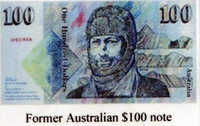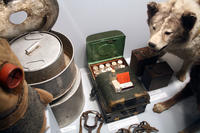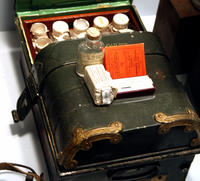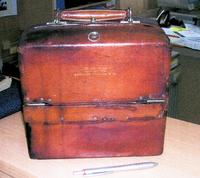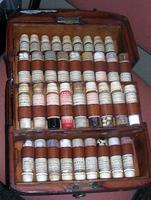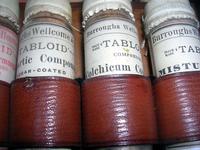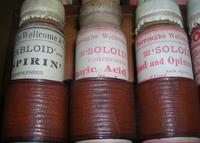
South Australian Medical Heritage Society Inc
Website for the Virtual Museum
Home
Coming meetings
Past meetings
About the Society
Main Galleries
Medicine
Surgery
Anaesthesia
X-rays
Hospitals,other organisations
Individuals of note
Small Galleries
Ethnic medicine
- Aboriginal
- Chinese
- Mediterran
Sir Douglas Mawson's Medical Kit
Acknowledgements:
The photographs were taken with the kind permission of Mark Pharaoh senior collections manager,
Mawson and History Science Collections Museum of South Australia, and Jeff Richbieth from
"Chemplus".
Mark Pharaoh also supplied much information on the life of Sir Douglas Mawson.
Sir Douglas Mawson, OBE, FRS, (1882-1958) is noted primarily for his Antarctic exploration which spanned 24 years (1907-1931). At the age of 2 his family migrated to Australia. He later attended Fort Street High, and graduated from the University of Sydney in Mining Engineering and Science.
In 1903 he was in the New Hebrides as a geologist, and in 1905 he joined the University of Adelaide as a Lecturer in Petrology and Mineralogy. While his first expedition to Antarctica was with Ernest Shackleton, the most reported expedition involved a three man sledging party led by Mawson with his two companions, Mertz and Ninnis. Their objective was to explore the Antarctic coast between the areas covered by the Terra Nova and Gauss expeditions. The party of three left the Main Base on 10/11/1912. The first tragic event occurred on December 14th, when Ninnis and a sledge with vital supplies vanished into a deep crevasse. An injured dog could be heard some 150 feet down but their ropes were not long enough to reach it.
The only option was for Mawson and Mertz to return to base. They continued their struggle but on January 1st, Mertz became ill and delirious. He died 100 miles from the base on January 7th. Mawson continued doggedly despite a nearly fatal fall into a crevasse. On January 27th he was fortunate to discover a depot with rations built by other explorers searching for the party. A note said that "Aladdin's Cave" was only 23 miles away and the ship Aurora was there. He was again held up by the weather, and by the time he reached Cape Dennison the Aurora was a speck on the horizon. The five men left behind to continue the search radioed the Aurora but a blizzard made the return impossible. Thus Mawson had to spend another winter in the Antarctic. Before their return the group explored a large coastal area describing its geology, biology, and meteorology.
On his return Mawson was Knighted and married Francisca Adriana (Paquita) Delprat. He served as a Major in WW1, and later was appointed Professor of Geology and Mineralogy at the University of Adelaide, making valuable contributions to the understanding of the geology of SA, particularly the Flinders Ranges. He made a further trip to Antarctica in 1929-1931 leading to the formation of the Australian Antarctic Territory. His photograph is immortalised on the first Australian $100 note.
The Mawson exhibit at the museum of SA.
One of the sledge dogs used at the base camp. He is poised over 2 cans of kerosene used to heat the "nansen" cooker (extreme left). The medical kit is in the centre, it has glass containers and an arm sling. In the foreground are 2 crampons used on ice trips.
The following photographs of Mawson's "Veterinary kit" are stored at the South Australian Office of the Pharmaceutical Society of Australia. The photographs have been taken with the kind permission of Jeff Richbieth.
Enlarged views of individual bottles containing tablets and drugs in common use in that era, some such as aspirin and opium may have been intended for human treatment.
-o0o-
